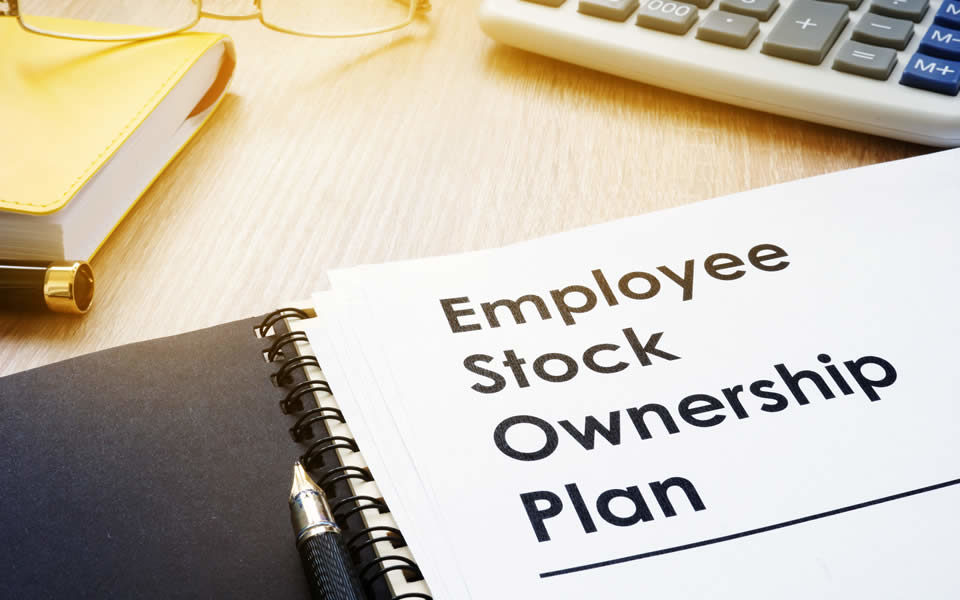Benefits Attributed to ESOP Companies
By Chad Bell, Senior, Advisory Services & Patrice Radogna, ASA, CPA, ABAR, Director, Advisory Services
An Employee Stock Ownership Plan (ESOP) is a tax-qualified defined contribution retirement plan, wherein the selling shareholder sells company stock to the ESOP. ESOPs are designed to invest primarily in the stock of the company, with the employees becoming the eventual beneficial company owners. When vested employees retire or terminate their employment, their allocated shares are repurchased by the company at the current fair market value.
Certain advantages and benefits of an ESOP are well-known to business owners.1 The most notable are the tax benefits and the unique and attractive succession, estate planning, and liquidity opportunities these plans provide to the owners/sellers of privately held companies, while still allowing business owners to continue leading their companies and preserve the careers of valued employees. Less frequently identified and discussed are the more intangible benefits, including reduced turnover, greater employee engagement and productivity, and the indirect economic benefits that may be created from employees receiving company stock at no cost to them.
Reduced Employee Turnover
By providing employees with company ownership , an inherent incentive is established for employees to remain at the company, and the motivation to increase company value is instilled in the workforce. This singular benefit has been shown to lead to greater and clearer motivation to maximize company performance and profitability since doing so economically benefits each employee-owner. Additionally, by aligning incentives, a shared interest in success is created, which is considered by many to be a possible pathway to reducing confrontation or conflict between executives and employees by encouraging cooperation towards achieving a common goal. Numerous studies have found that a more committed and engaged workforce has resulted in ESOP companies having lower overall employee turnover, if the requisite ownership culture has been established. In December 2018, the National Center for Employee Ownership (NCEO) surveyed ESOP companies and found that the voluntary and involuntary average separation rates for employees over a four-year period were each less than half of their respective national average rates.2
Increased Company Performance
With the focus on business performance heightened for ESOP employees, it is not surprising that academic and practitioner research has identified a statistically significant correlation between employee ownership and company performance. These studies of employee-owned companies have found that ESOP companies outperform non-ESOP companies. Additionally, performance and profitability were found to be positively impacted by ESOP participation levels and time, potentially related to the implementation of more effective ownership cultures.3 Increased profitability has been attributed to the fact that, although not every employee can boost sales or influence a customer’s experience, each can have a role in improving processes and minimizing waste.
The 2019 ESOP Economic Performance Report4 found for the fourth year in a row that ESOP companies reported profits rose at rates greater than revenue. The ESOP Association speculated that these companies were succeeding at minimizing costs, and that employee-owners may have assisted in these efforts. Respondents revealed that 75% of ESOP employees were involved to a significant degree in keeping down costs and helping companies improve profit margins in order to share in benefits.
One of the most comprehensive studies was conducted by Rutgers University in 2000. The study analyzed over 300 ESOP companies and compared them to non-ESOP companies with industry, size, and geographical similarities. The findings showed that ESOPs grew more than 2% faster per year after implementing their ESOP than would have been expected without the plan. Other studies found that productivity improves by more than 4% in the year the ESOP is established, and this higher productivity level is maintained in subsequent years.5
Higher Retirement Savings
Many employees at all compensation levels do not save enough for a comfortable retirement. Decades of research has shown that: (i) ESOP companies are more likely to offer secondary retirement plans than non-ESOP companies are to offer a single plan; (ii) ESOP participants have considerably more retirement savings; (iii) ESOPs overall not only have higher rates of return than 401(k) plans, but are also less volatile; and (iv) ESOPs cover a greater number of, and are better designed for, lower income and younger employees than 401(k) plans. In December 2018, the NCEO reported that ESOP participants surveyed had more than twice the average amounts in retirement accounts than the national average – approximately $170,000 as compared to $80,000.6
Secondary Impact of Increased Savings
The most recent research studies have revealed that ESOPs’ greater retirement savings can serve to reduce wealth inequality. Researchers discovered that ESOPs enable families to significantly increase their assets, reducing gender and racial wealth gaps, suggesting employee ownership can reduce wealth inequality. Additionally, the greater retirement savings that ESOPs afford and the absence of a participant contribution requirement reduces asset insecurity and can provide for retirement assets for those who may otherwise be unable to afford to contribute.7 While employees are generally required to sign up and select their deferrals with a 401(k) plan, in an ESOP, the company is required to allocate contributions based on the ESOP plan documents. A non-ESOP company may or may not make contributions or match based on the amount of an individual employee’s contributions. In fact, only approximately 56% of companies offer a match to employees’ contributions to 401(k) plans when they start.8
Conclusion
ESOPs operate under the concept that if increased company performance and profitability directly benefits plan participants, employees will have greater incentive to increase productivity and profits. As discussed, an ESOP can significantly benefit both employees and owners and be an ideal solution under certain circumstances. The process of implementing an ESOP requires a team of experienced professionals; the first step in determining if an ESOP is practical for your company or that of your clients is a discussion with a team of dedicated ESOP advisors.
SOURCES
- Ownership through the Employee Stock Ownership Trust.
- Wiefek, Nancy and Nathan Nicholson. S Corporation ESOPs and Retirement Security, National Center for Employee Ownership, December 2018.
- O’Boyle, Ernest H., Patel, Pankaj C. and Gonzalez-Mulé, Erik. Employee ownership and firm performance: a meta-analysis. Human Resource Management Journal, June 24, 2016.
- 2019 ESOP Economic Performance Report, The ESOP Association © 2019.
- Kruse, Douglas and Joseph Blasi, Employee Ownership, Employee Attitudes, and Firm Performance Handbook of Resource Management Handbook. Greenwich, CT.: JAI Press, 1997.
- Wiefek, Nancy and Nathan Nicholson. S Corporation ESOPs and Retirement Security, National Center for Employee Ownership, December 2018.
- Blasi, Joseph and Douglas Kruse, Building the Assets of Low and Moderate Income Workers and their Families: The Role of Employee Ownership. Institute for the Study of Employee Ownership and Profit Sharing, March 2019.
- How America Saves 2019, Vanguard 2018 Defined Contribution Plan Data, © 2019 The Vanguard Group, Inc.



















